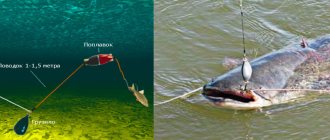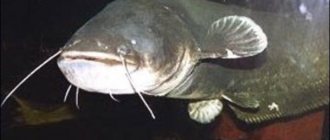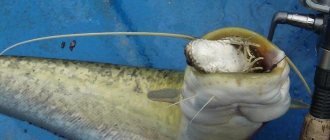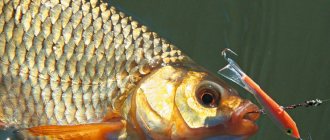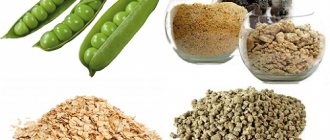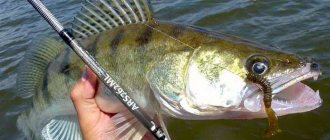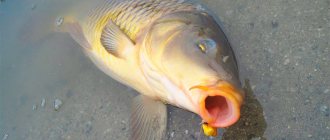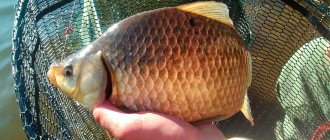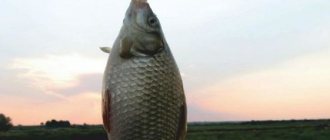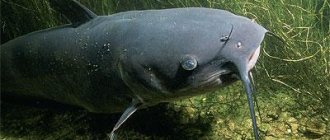Pike fishing is always an exciting and exciting activity. But sometimes it happens that the pike stops biting at any bait and you have to come up with new effective methods. But why rack your brains if everything has already been thought out in advance! If the pike has stopped taking bait, then we catch it with live bait. And as live bait we choose mugs. We'll tell you what it is and how to catch it.
Fishing circle equipped with d=180mm Helios 123 for 1 piece. Fishing circle equipped with d=150mm Helios 117 for 1 piece. Fishing circle equipped with d=130mm Helios 105 for 1 piece. Fishing circle d=130mm Helios 72 for 1 piece. Fishing circle d=150mm Helios 82 for 1 piece. Fishing circle d=180mm Helios 98 for 1 piece.
Select a fishing circle in the catalog
Mugs are unpretentious equipment, quite simple to equip.
Equipment for pike fishing circles
If a person has already dealt with fishing and is able to equip the same girder, then there will definitely not be any difficulties with the mugs. But for a beginner, this method of fishing can be difficult. However, manufacturers have provided for everything and mugs can be purchased either without equipment or completely ready for use.
Triple hook (HS-ST-36-5) Helios 24 for 1 pc. Tee ST36BN-No. 5 FORMIX 20 for 1 pc. Triple hook 974 No. 1 EAGLE CLAW 14 for 1 pc. Triple hooks “Sprut” Kawa ST-31 BC #2 (Treble Wide Gap Hook) 1pack*6pcs Sprut 380 for 1 pack. Triple hook ROUND (3R-BLN-01) METSUI 975 for 1 pack. Triple hook OWNER ST-46BC, No. 1 OWNER 19 for 1 pc. Triple hooks “Sprut” Hara ST-36 BC #4 (Treble Round Bend Hook) 1pack*7pcs Sprut 340 for 1 pack. Triple hooks Round Treble art. KH11030-02/1 Rubicon 520 for 1 pack. Tee HF-36 Needle point, #5 Hitfish 185 for 1 pack. Tee HF-36 Needle point, #4 Hitfish 185 for 1 pack.
Select a tee for circles
Design of circles for pike fishing
The tackle is a foam circle with a diameter of 13 to 20 cm and a thickness of 20-30 mm, along its end there is a groove for fishing line, in the middle there is a mast about 15 cm in length with a serif at the top.
Profi Spector fishing line 100 meters transparent EXPERT 122 for 1 pc. Profi Spector fishing line 100 meters green EXPERT 122 for 1 pc. Line CULT CARP DEEP PURPLE 150 m Climax 310 for 1 pc. Line Aller DG 150 m, 10 kg Nautilus 264 for 1 piece. Floating line Kruiser Control Liner 0.33 mm, 150 m, 12lb KM12 Korda 680 for 1 pc.
Buy fishing line for rigging circles
To assemble a standard circle, you will need the following:
- a circle with a mast-pin;
- main cord or fishing line 0.25 - 0.45 mm, a length slightly greater than the depth of the reservoir in the chosen fishing location;
- fishing line 1.8 - 2.5 mm, on a retractable leash, up to a meter long;
- steel or fluorocarbon leash 20 – 30 cm, with a carabiner;
- sliding weight;
- swivel
Next, we think about what kind of mugs we want to see – stationary or free-floating. Their equipment differs quite a bit.
Leash equipped dl. 25cm. test 15kg. PIERCE 30 for 1 piece. Fluorocarbon leash 0.6mm 16.5kg 20cm (HS-0064) Helios 105 for 1 pack. Fluorocarbon leash 0.5mm 13.8kg 30cm (HS-0056) Helios 95 for 1 pack. Leash equipped dl. 25cm. test 9kg. PIERCE 20 for 1 piece. Fluorocarbon leash 0.4mm 8.5kg 30cm (HS-0046) Helios 95 for 1 pack. Fluorocarbon leash 0.4mm 8.5kg 20cm (HS-0044) Helios 95 for 1 pack. Leash AFW 7 threads 0.28mm 9kg 20cm (3pcs/pack) Helios (HS-0096) 105 per 1 pack. Leash String D-0.33 mm, dl - 30 cm (pack) Helios 127 for 1 pack. Fluorocarbon leashes (20cm/0.40mm/5kg) 1pack*3pcs Sprut 240 per 1pack. Leash AFW 7 threads 0.30mm 14kg 25cm (3pcs/pack) Helios (HS-0101) 105 for 1 pack.
Choose a leash for equipping circles
Homemade circle for pike
There are also such unique designs as mugs made from a plastic bottle or tin can. It’s hard to say which circle is better; it all depends on the angler’s habits, conditions and fishing location.
Optimal sizes
As mentioned above, the optimal size of the circle is from 13 to 18 cm, but not everything is so simple here, it all depends on what kind of fish to catch and what size of live bait will be used. Also, the size of the mug depends on the material from which it is made. Mugs that are made from cork or foam are smaller in size than wooden ones and rarely exceed 13 cm in diameter.
If you are going to catch trophy specimens of pike, then the diameter of the circle should be within 18-20 cm. The thickness of the circle does not depend on the material and rarely exceeds 3 cm.
The process of making a tackle-mug with your own hands
To make a mug from wood, it is better to use a lathe; this will make the work much easier and the mug will have a neat appearance.
Materials for making a mug
Mugs made from lighter materials (cork, polystyrene) are easy to process, but at the same time they are quite fragile and will not last long. They also float excessively and in strong winds on a pond, it will be difficult for you to keep track of them.
Making mugs from wood is a more labor-intensive process, but the service life of such mugs, if processed correctly, will be longer. They are also a little heavier than foam or cork and won't blow around as easily.
Less traditional materials, such as a tin can or plastic bottle, can also be used to make mugs.
Making a mug
Let's consider the option of making a traditional pin circle from extruded polystyrene foam, it is also called penoplex, this material can be bought at any construction supermarket
The process of making mugs from wood is, in principle, no different from making mugs from foam plastic. It is better to cut a circle from linden; it is easy to process and has good buoyancy.
It is more convenient to cut and process the circle on a lathe. The wooden circle is subject to more careful processing. After sanding, the circle must be soaked in drying oil and puttied.
It is better to use a two-component putty based on tsapan varnish and BF2 glue. When the circle dries, it needs to be sanded again with sandpaper and painted. The paint can be used either nitro or oil based.
The upper part of the disk, which is above the water, is painted in a bright color, most often red or orange, and the lower part is covered with white paint.
For circles that are made of wood, you need to insert a cork insert into the middle of the hole for the mast, this will increase the clamping force of the latter.
To avoid excessive buoyancy of foam circles, some fishermen resort to this trick: a saucer-shaped recess is made in the middle of the circle and during windy weather it is filled with water; under its weight, the circle sinks more into the water and sails less.
Materials for making a mast
A mast is inserted into the hole in the circle. Wood (pine, spruce) or plastic is used to make the mast. Some fishermen use a metal-plastic pipe with a diameter of 10 mm as a mast.
Making a mast
The size of the stick is tied to the diameter of the circle itself. If the mast is made of wood, it has a cone-shaped shape, the length of the mast is in the range of 15-18 cm, at the lower end, which will be under water, a spherical thickening with a diameter of 2.5-3 cm is made.
In the upper part, a cut is made up to 2 cm deep, into which the fishing line will be inserted. The middle part of the mast is painted white, and the upper part with the cut is black, this combination of colors makes the circle more noticeable.
The lower spherical part is painted half white and black; this coloring helps to distinguish whether the circle rotates after a bite or not. The mast not only acts as a regulator of the stability of the circle and facilitates its turning over, but also with the length of the stick you can regulate the course of the circle and reduce the number of idle bites or unauthorized turning of the circle due to gusts of wind.
Free floating circle
- Using a simple loop, we attach the main fishing line or cord to a standard foam circle and wind it into the end groove;
- We equip the other end of the fishing line with a sinker and tie a swivel;
- We attach a long leash to the swivel so that the live bait can move more freely and not be restricted;
- and to this leash we attach a steel leash with a hook, on which the bait will be held. That's it, the circle with free live bait is ready to be launched into the water.
Swivel (HS-ZPY-1024-12) Helios 37 for 1 pack.
Swivel (HS-ZPY-1024-8) Helios 37 for 1 pack. Swivel with Safety fastener No. 6, test 7 kg (8 pcs/pack) Nice FISH SEASONS 60 per 1 pack. Kipper No-Knot Fast-Snap Black Large 63 for 1 piece. Swivel with sliding clasp INTERLOCK MATCH SNAP L, 18 kg (10 pcs/pack) Helios (HS-ZPY-1115-1-L) Helios 54 for 1 pack. Swivel with bearing BALL BEARING SWIVEL No. 1, 20 kg (10 pcs/pack) Helios (HS-ZPY-1110-1) Helios 159 for 1 pack. Rolling swivel (AX-92113-10) AXIS 48 for 1 pack. Swivel clasp DOUBLE PLASTIC №L FISH SEASONS 60 per 1 pack. Swivel clasp DOUBLE PLASTIC №M FISH SEASONS 60 per 1 pack. Choose a swivel for the mug
The process of making a tackle-mug with your own hands
If you decide to make the tackle yourself, then this process can be divided into the following stages:
- To make a mug, foam plastic with a thickness of 15-20 mm is used.
- A circle with a diameter of 150 mm is marked with a compass and pencil.
- Cut the workpiece with a sharp knife.
- A groove 10 mm deep is machined on the end part.
- To ensure smoothness, the groove is treated with sandpaper.
- A hole with a diameter of 6-8 mm is made in the center of the circle.
- On the upper plane, two small slots are made opposite each other from the outside to secure the fishing line.
- The end of the wooden strip for the 8-8-150 pin is ground down to a cone.
- At its other end, a groove is cut 10 mm deep and 3 mm wide.
- The disk and mast are painted. The disc is red on top and white on the bottom, and the mast is the opposite.
- A cord 10-15 m long is wound around a circle.
- The metal leash is attached to the cord through a swivel.
- A movable weight is attached to the leash.
- A hook is attached to the end of the leash.
All installations are done on hinges.
primanki.com
Fixed circle
The equipment of the stationary circle differs only in the location of the weight:
- Having wound the main cord around the circle, we put a swivel on it;
- We tie a weight to the end of the cord;
- to limit the sliding of the swivel along the cord, we fix its position with two stoppers, thereby determining at what depth the live bait will swim;
- after that, as with the floating circle, we tie a leash with a hook to the swivel.
The choice of installation depends on where you are fishing - on a river or on a lake, as well as on weather conditions.
For som
Fishing this fish into mugs is a fairly old method. And the fact that it is still a priority for many professionals suggests that this is a fairly effective method. Catching catfish with a circle is a passive form of fishing. That is, vigilant monitoring of the tackle and constant hooking are not required. It is enough to simply place the mugs around the pond and watch from the shore or boat from afar which one will capsize in order to remove the prey and re-throw it.
As you know, catfish mainly live in large rivers and large canals where there is a current. And this is a big problem for fishing with ordinary mugs. The current really interferes with fishing. Of course, today there are many artificial reservoirs, in the still waters of which this fish also lives, but professionals have still found a way out that allows them to fish with mugs in fast water.
When fishing for catfish with a circle, you can use not only traditional types of bait, but also frogs or rotten meat as bait. Those who opt for live bait need to know that they put it through the back on large single hooks.
Fishing with a circle from the shore in still water differs from fishing in the current in that in the latter case the tackle is not held by a weight, but is allowed to float freely. And she, rafting on the water, finds the prey herself. In addition to catfish, pike and perch are excellently caught on the circle, so you should not be surprised if, when you set a “trap” for one fish, you find a completely different one in it. By the way, for predators such as catfish or pike, it is necessary to install long metal leashes.
Installation of circles
Fixed circles are needed if you plan to fish a specific place or if its movement will be hampered by snags and algae. Then we equip the circles according to the second type, where a load tied from below will play the role of an anchor.
Installation:
- We unwind the main line to the full depth to the bottom;
- Using stoppers we set the depth at which the live bait will swim;
- baiting with live bait;
- put the tackle on the water and unwind the fishing line until the load touches the bottom;
- We leave about half a meter of fishing line for more freedom and clip the fishing line on the mast.
But this installation method has its drawbacks. For example, after a bite, the load will drag along the bottom and can scare away the predator, and in strong waves and wind the circle may spontaneously turn over.
DIY mugs for pike from a bottle
This type of circles has not found wide application, but has the right to life.
Making such a circle will not be difficult; here is the procedure for preparing such a circle:
The mugs used for pike fishing must be the same size, especially in thickness. For ease of transportation and storage of mugs, the mast does not need to be tightly attached to the mug. And we must remember that the success of pike fishing depends on many factors, including knowledge of the reservoir, the ability to choose the right tackle and bait, as well as the personal qualities of the fisherman.
Source
Permanent installation without anchor
If you need a stationary circle, but do not want to use traditional anchor equipment, then you can anchor the circles with a floating anchor. To do this, we attach the mugs to a log or board, having previously anchored the latter with a heavy load. We tie the circle by tying a cord around the lower underwater part of the mast. In this case, the fastening will not interfere with the free flow of the fishing line when biting and turning over the circle. You can also tie it to stationary natural “anchors” - snags protruding from the water, tree branches, reeds.
We place the mugs in the same way as in the current, but before launching into the water we tie them to the selected objects.
Read also
Mugs - a modern approach
Mugs - a modern approach Quite a lot and in detail has been written about fishing with mugs, but very little or nothing is said in the existing literature about the design of the circle itself, the dynamics of its development. It does not take into account that in each specific case, on one
Fishing with mugs
Fishing with mugs Unfortunately, most fishermen almost never catch perch with mugs on purpose, preferring a spinning rod or a live bait fishing rod. Perch is undeservedly ignored by fishermen - circle fishermen, and if it ends up in catches, it is as a random trophy. This is happening
For mugs and supplies
On mugs and supplies Mugs are one of the most rational ways of catching pike not only in closed reservoirs, but also on the current. Circle fishermen, not without reason, believe that they know the habits of predatory fish and their places of accumulation better than other fishermen, and therefore they fish without
For mugs and supplies
For mugs and supplies Very often, mugs for burbot have to be anchored when “white lambs” are walking on the pond. Under these conditions, excessive delay in installing them is not acceptable, since a sailing boat may overshoot the desired location. When fishing for burbot in a moderate wind
Fishing with mugs
Fishing with mugs Most often, stationary mugs or stands are installed. They are the most effective in catching predators. In a strong current, having released the required amount of fishing line, it is fixed in the side slot of the circle, from which it can be released
Stationary floats
Fixed Floats Fixed, or stationary, floats have one, two or more attachment points to the line. Options with one attachment point can only be used in quiet bodies of water with standing water or in weak currents. It’s convenient with such a float
Fishing with mugs
Fishing with mugs Floating girders, colloquially referred to as mugs, are associated by most anglers exclusively with fishing for predators, mainly pike perch and pike perch. But carp, with its sharp and confident bite, is perhaps the only one of our “peaceful” fish
Mugs
Mugs Mugs, also known as floating girders, work on the same principle as ordinary, stationary girders - after grabbing a predator, they have the opportunity to reel off a certain supply of fishing line from the mug and at the same time calmly swallow live bait. But a self-catching girder, unlike a girder,
[THERE IS AN ANSWER] How to put live bait on a pike hook
Stationary traps
Stationary traps Traps that are open at the top and constantly stand in one place - such that it is impossible to move them to another place without disassembling them - have been used since ancient times in the coastal zone of the sea, preventing fish from approaching the shores
Mugs
Mugs The design of mugs intended for catching pike perch and pike is no different - the same mug will successfully catch both predators. Equipment is a different matter: for catching pike perch, mugs are equipped differently. Firstly, the requirements for strength increase
Mugs
Mugs A popular and active way of hunting predators using a boat. The tackle is a small flat disk made of wood, dense foam or other lightweight materials that do not sink in water, with a groove along the edge on which a fishing line is wound. The line is passed through
FISHING WITH MUGS
FISHING WITH MUGS Catching predatory fish with mugs in open water is very interesting and productive in open water. Especially in places where predators gather. They fish with this tackle from a boat in lakes, reservoirs, on wide river reaches and bays. In general, mugs can be classified as active gear,
PINLESS MUGS
PINLESS MUGS Sometimes the new is the well-forgotten old. Pinless mugs were used by fishermen back in the days of L.P. Sabaneeva. “Sometimes they fish with circles without a rod, pinching the twine into a split on the edge of the disk,” he wrote in his famous book on catching freshwater
Fishing with mugs and supplies
Fishing with mugs and rigs Mugs are one of the most rational ways of catching pike not only in closed reservoirs, but also in the current. Circle fishermen, not without reason, believe that they know the habits of predatory fish and their places of accumulation better than other fishermen, and therefore they fish without
For mugs
Most often, stationary mugs or large-sized stands are installed on mugs. They are the most effective in catching predators. In a strong current, having released the required amount of fishing line, it is fixed in the side slot of the circle, from which it can
All installations are done on hinges.
Fishing technique with mugs
The principle of operation of the circles is simple - live bait swims in the layer of water that the weight sets for it. The pike, having grabbed the bait, begins to pull the line, as a result of which the circle turns over. For the fisherman, this is a signal of a bite. The line pulled out from the mast latch is freely released, preventing the pike from feeling the tackle. The fisherman, swimming up to the inverted circle, makes a hook and fishes out his prey.
We must remember. that, according to the law, when fishing with circles, a certain number of hooks is allowed. Fishing on the territory of the Russian Federation using recreational fishing gear is permitted with a total number of hooks from 6 to 10 per fisherman. It varies depending on the region. But, to be honest, it’s difficult to keep track of a large number of circles with a normal bite.
Equipment mug
The mug rig for catching toothy fish is lightweight and easy to use and manufacture.
The main parts of this type of equipment are:
- The disk of the circle, which has special notches to preserve the fishing line and a hole for the antenna;
- A stick with a hole for threading monofilament thread;
- Line with a diameter of 0.3-0.5 mm;
- Weight;
- Nozzle for further securing live bait;
- Leash.
fishing line
To equip a homemade circle, you must first prepare a fishing line with a diameter of 0.3-0.5 mm.
Moreover, you should definitely know the depth of the reservoir where you are going to fish. Since experts recommend making a small supply of monofilament.
So, it is advised to make the fishing line longer by 6-8 m from the depth of the fishing spot. Most often, 15-20 m of fishing line is completely enough.
In the case when catching a toothy predator will be done at great depths, it is recommended to attach a small piece of foam to the fishing line.
You can also use rubber. This will allow you to independently adjust the fishing depth.
Sinker and Hook
A sliding weight weighing 15 g is used as a sinker.
You can use any pike hook or treble hook. Here the opinions of experts and amateurs differ. But most often they decide to use a double hook.
Nozzle
Most often, circles are caught using live bait.
The best bait options for this method of fishing for toothy predators are:
- rudd;
- loach;
- ruff;
- perch;
- perched water;
- silver bream;
- rudd;
- gudgeon and much more.
Seasonality of fishing with mugs
Depending on the season, the equipment of the circles will vary slightly. It depends mainly on the activity of the pike. In summer, it is less active, hunts mainly in the upper layers of water, and, accordingly, attaches live bait within its visibility. Pike hide in thickets of algae and coastal reeds. Therefore, the method of rafting downstream along such places should bring good results. During this period, there are very few places where you can catch pike on a long rafting trip.
In the fall, the predator becomes more active and goes to a depth of three meters. And as the weather gets colder, more and more places free from algae appear, which makes fishing for pike with mugs more and more interesting and varied. By rafting you can fish different channels, walk along the shore, fish holes and other promising places. Autumn is a time of winds; using the wind, you can carry out long rafting trips on the lakes. The increased transparency of the water also contributes to a successful bite, attracting predators from a larger water area.
The disadvantages of this season include worsening weather, strong winds, rain and fog.
DIY pike circle
Mugs are floating tackle for catching predatory fish (pike, pike perch, perch) with live bait. This tackle is very catchy both in terms of quantity and quality of fish caught.
The most widespread among fishermen are mugs in the form of a foam plastic disc, although mugs can also be made from wood, a plastic bottle, or a tin can.
